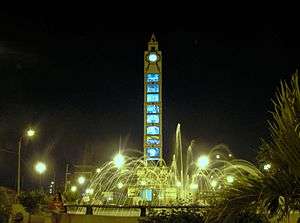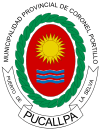Pucallpa
| Pucallpa May Ushin Pukallpa | |||
|---|---|---|---|
|
Pucallpa Plaza and San Martín Fountain | |||
| |||
| Nickname(s): La tierra colorada (The Crimson Land) | |||
 Pucallpa Location in Peru | |||
| Coordinates: 8°23′S 74°31′W / 8.383°S 74.517°W | |||
| Country | Peru | ||
| Region | Ucayali | ||
| Province | Coronel Portillo | ||
| Settled | 1840s | ||
| Elevation | 154 m (505 ft) | ||
| Population (2007) | |||
| • Total | 204,772 | ||
| • Estimate (2015)[1] | 211,651 | ||
| 2007 census | |||
| Time zone | PET (UTC-5) | ||
| • Summer (DST) | PET (UTC-5) | ||
| Website | www.mpcp.gob.pe | ||
Pucallpa (Quechua: puka allpa, "red earth") is a city in eastern Peru located on the banks of the Ucayali River, a major tributary of the Amazon River. It is the capital of the Ucayali region, the Coronel Portillo Province and the Calleria District.
History and Transportation
Pucallpa was founded in the 1840s by Franciscan missionaries who settled several families of the Shipibo-Conibo ethnic group.[2] For several decades it remained a small settlement as it was isolated from the rest of the country by the Amazon Rainforest and the Andes mountain range. From the 1880s through the 1920s a railway project to connect Pucallpa with the rest of the country via the Ferrocarril Central Andino was started and dropped several times until it was finally abandoned. Pucallpa's isolation finally ended in 1945 with the completion of a highway to Lima through Tingo Maria. The highway allowed the commercialization of regional products to the rest of the country, thus improving the economic outlook of the region and its capital, Pucallpa. However, the heavy rainfalls of the Amazon Rainforest remain a problem as they erode the highway and can even undermine it by causing flash floods. Pucallpa is served by air through the Captain Rolden International Airport and by river through its port Pucallpillo near the center of the city. During the high water season, the floating ports of La Hoyada and Puerto Italia are used for riverine communications. Pucallpa is connected by road to Lima via the cities Huánuco and Cerro de Pasco. The San Lorenzo Megaport Project proposes to connect Lima with the Atlantic via a rail connection to Pucallpa and the Amazon.[3]

Climate
| Climate data for Pucallpa | |||||||||||||
|---|---|---|---|---|---|---|---|---|---|---|---|---|---|
| Month | Jan | Feb | Mar | Apr | May | Jun | Jul | Aug | Sep | Oct | Nov | Dec | Year |
| Average high °C (°F) | 32.6 (90.7) |
31.5 (88.7) |
31.6 (88.9) |
31.7 (89.1) |
31.8 (89.2) |
31.2 (88.2) |
31.4 (88.5) |
32.9 (91.2) |
33.1 (91.6) |
32.6 (90.7) |
32.6 (90.7) |
32.4 (90.3) |
32.1 (89.8) |
| Average low °C (°F) | 21.2 (70.2) |
21.2 (70.2) |
21.0 (69.8) |
21.0 (69.8) |
20.4 (68.7) |
19.4 (66.9) |
18.7 (65.7) |
19.2 (66.6) |
20.0 (68) |
20.7 (69.3) |
21.0 (69.8) |
21.1 (70) |
20.4 (68.7) |
| Average rainfall mm (inches) | 156.7 (6.169) |
182.2 (7.173) |
228.5 (8.996) |
167.8 (6.606) |
93.8 (3.693) |
64.9 (2.555) |
49.1 (1.933) |
63.7 (2.508) |
115.0 (4.528) |
210.7 (8.295) |
197.4 (7.772) |
170.5 (6.713) |
1,700.3 (66.941) |
| Source: Senamhi[4] | |||||||||||||
See also
- Tapiche Ohara's Reserve
- TANS Peru Flight 204 crash, August 23, 2005.
- LANSA Flight 508 crash, December 24, 1971.
- Yarinaqucha
References
- ↑ Perú: Población estimada al 30 de junio y tasa de crecimiento de las ciudades capitales, por departamento, 2011 y 2015. Perú: Estimaciones y proyecciones de población total por sexo de las principales ciudades, 2012-2015 (Report). Instituto Nacional de Estadística e Informática. March 2012. Retrieved 2015-06-03.
- ↑ (Spanish) Alberto Tauro del Pino, Enciclopedia Ilustrada del Perú, vol. XIII, p. 2129.
- ↑ "Executive Summary". San Lorenzo Megaport Project. Retrieved 28 June 2014.
- ↑ "Promedio de temperaturas y lluvias para todo el año–Pucallpa" (in Spanish). Servicio Nacional de Meteorología e Hidrología del Perú. Retrieved 22 December 2015.
External links
| Wikimedia Commons has media related to Pucallpa. |
 Pucallpa travel guide from Wikivoyage
Pucallpa travel guide from Wikivoyage
Coordinates: 8°23′S 74°33′W / 8.383°S 74.550°W

